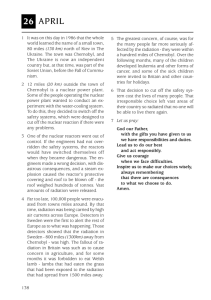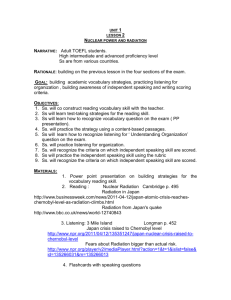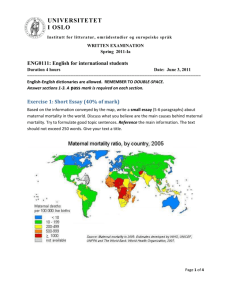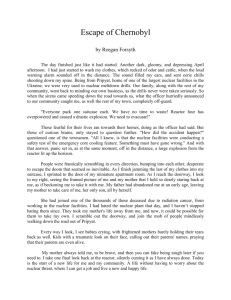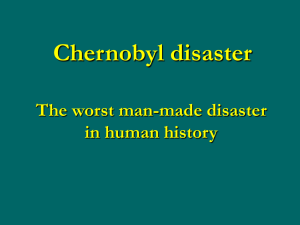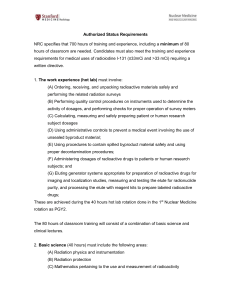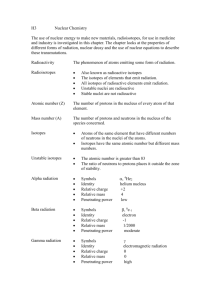Enviro 20 Case Study nuclear accidents
advertisement
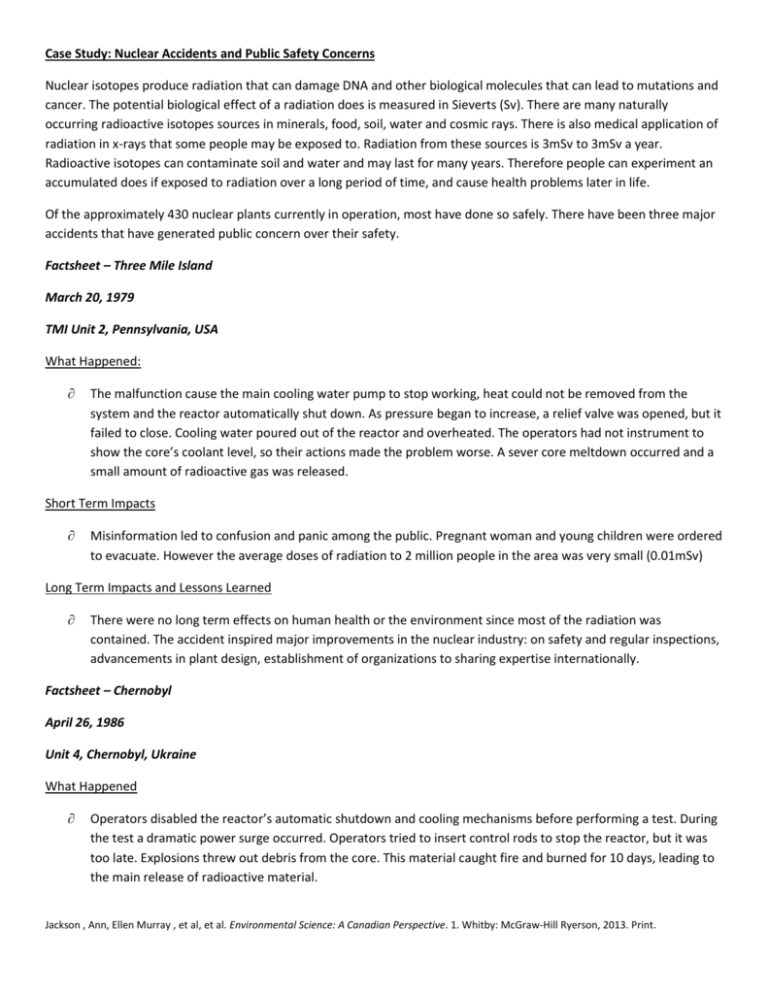
Case Study: Nuclear Accidents and Public Safety Concerns Nuclear isotopes produce radiation that can damage DNA and other biological molecules that can lead to mutations and cancer. The potential biological effect of a radiation does is measured in Sieverts (Sv). There are many naturally occurring radioactive isotopes sources in minerals, food, soil, water and cosmic rays. There is also medical application of radiation in x-rays that some people may be exposed to. Radiation from these sources is 3mSv to 3mSv a year. Radioactive isotopes can contaminate soil and water and may last for many years. Therefore people can experiment an accumulated does if exposed to radiation over a long period of time, and cause health problems later in life. Of the approximately 430 nuclear plants currently in operation, most have done so safely. There have been three major accidents that have generated public concern over their safety. Factsheet – Three Mile Island March 20, 1979 TMI Unit 2, Pennsylvania, USA What Happened: The malfunction cause the main cooling water pump to stop working, heat could not be removed from the system and the reactor automatically shut down. As pressure began to increase, a relief valve was opened, but it failed to close. Cooling water poured out of the reactor and overheated. The operators had not instrument to show the core’s coolant level, so their actions made the problem worse. A sever core meltdown occurred and a small amount of radioactive gas was released. Short Term Impacts Misinformation led to confusion and panic among the public. Pregnant woman and young children were ordered to evacuate. However the average doses of radiation to 2 million people in the area was very small (0.01mSv) Long Term Impacts and Lessons Learned There were no long term effects on human health or the environment since most of the radiation was contained. The accident inspired major improvements in the nuclear industry: on safety and regular inspections, advancements in plant design, establishment of organizations to sharing expertise internationally. Factsheet – Chernobyl April 26, 1986 Unit 4, Chernobyl, Ukraine What Happened Operators disabled the reactor’s automatic shutdown and cooling mechanisms before performing a test. During the test a dramatic power surge occurred. Operators tried to insert control rods to stop the reactor, but it was too late. Explosions threw out debris from the core. This material caught fire and burned for 10 days, leading to the main release of radioactive material. Jackson , Ann, Ellen Murray , et al, et al. Environmental Science: A Canadian Perspective. 1. Whitby: McGraw-Hill Ryerson, 2013. Print. Short Term Impacts Chernobyl was the largest nuclear accident ever, releasing 400 times more radioactive material than the bombing of Hiroshima. Thirty one workers were killed. Airborne materials were carried by wind over a large area of Ukraine, Belarus, Russia and parts of Europe. Within a 30km radius, 116 000 were evacuated from their homes. Long Term Impacts and Lessons Learned There was an increase in thyroid cancer, especially in exposed children. Anxiety over radiation effects and relocation caused major stress for residents. Analysis of the Chernobyl accident has led to improvements in reactor safely, particularly in Soviet-designed plants of Eastern Europe. Factsheet – Fukushima March 11, 2011 Daiichi Units 1-3, Fukushima, Japan What Happened On March 11, 2011 a major earthquake occurred off Japan’s northeast coast. At the nearby Daiichi plan only 3 of the 6 reactors were operating. The reactors shut down as designed and sustained no significant earthquake damage. However, a 15m tsunami flooded the site, causing a loss of power. The flooding also disabled the backup generator of the mechanism for removing excess heat. Most of the three cores melted in a few days and several hydrogen explosions occurred. Water in the site’s waste storage pools started to boil away; causing fuel rods to melt and burn. Officially “col shutdown” was not achieved for 9 months. Short Term Impacts There were no deaths that occurred, but 100 000 people had to be evacuated from their homes. Although the fuel was essentially contained, radioactive substances leaked out into the air and water. As well, elevated radiation levels were found in some local food and water sources. Nearly 20 000 people were exposed to radiation while conducting clean-up efforts on the site. A total of 167 workers received radiation does over 100mSv, of whom 6 received more than 250mSv Long Term Impacts and Lessons Learned Because the accidents occurred recently, the long-term effects are not yet known. However, Japan has halted any expansion of nuclear power and is conducting extensive safety assessments of all existing reactors. A number of countries have since announced plans to reduce or abandon nuclear power and turn towards renewable energy sources. The Fukushima reactors are an older design that needs electrical power for cooling during an emergency shutdown. Even though the reactors withstood the earthquake itself, the tsunami’s disabling of the power grid and backup generators lead to a serious nuclear accident. Jackson , Ann, Ellen Murray , et al, et al. Environmental Science: A Canadian Perspective. 1. Whitby: McGraw-Hill Ryerson, 2013. Print. Analyze and Conclude 1. Analyze the circumstance that led to each of the three nuclear accidents. Consider the roles of equipment malfunction, design flaws, human error, and a natural disaster. What can you conclude about the safety of nuclear energy production and nuclear reactors by analyzing these factors? 2. Use point form to summarize how local people and environment were affected by one of the accidents described. How might the circumstances have affected the mental health and social conditions of the people in the region? Communicate 1. Imagine that your province has announced plans to expand nuclear power generation. Write a short letter to your member of provincial parliament or member of legislation assembly to express your support for or concerns about public safety in regards to nuclear power. Jackson , Ann, Ellen Murray , et al, et al. Environmental Science: A Canadian Perspective. 1. Whitby: McGraw-Hill Ryerson, 2013. Print.

